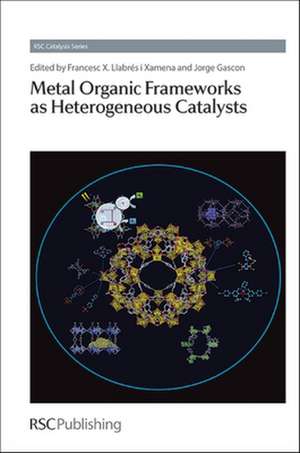Metal Organic Frameworks as Heterogeneous Catalysts: RSC Catalysis, cartea 12
James J. Spivey, Zinfer Ismagilov Editat de Fransesc Llabres i Xamena, Jorge Gasconen Limba Engleză Hardback – 7 iul 2013
Din seria RSC Catalysis
- 14%
 Preț: 941.61 lei
Preț: 941.61 lei - 14%
 Preț: 1369.88 lei
Preț: 1369.88 lei - 14%
 Preț: 1363.60 lei
Preț: 1363.60 lei - 14%
 Preț: 1120.35 lei
Preț: 1120.35 lei - 14%
 Preț: 1119.00 lei
Preț: 1119.00 lei - 14%
 Preț: 1347.55 lei
Preț: 1347.55 lei - 14%
 Preț: 1381.56 lei
Preț: 1381.56 lei - 14%
 Preț: 1248.32 lei
Preț: 1248.32 lei - 14%
 Preț: 1244.21 lei
Preț: 1244.21 lei - 14%
 Preț: 1081.57 lei
Preț: 1081.57 lei - 14%
 Preț: 1369.04 lei
Preț: 1369.04 lei - 14%
 Preț: 1378.97 lei
Preț: 1378.97 lei - 14%
 Preț: 1393.17 lei
Preț: 1393.17 lei - 14%
 Preț: 1547.47 lei
Preț: 1547.47 lei - 14%
 Preț: 775.38 lei
Preț: 775.38 lei - 14%
 Preț: 1132.10 lei
Preț: 1132.10 lei - 14%
 Preț: 946.72 lei
Preț: 946.72 lei - 14%
 Preț: 948.21 lei
Preț: 948.21 lei - 14%
 Preț: 958.32 lei
Preț: 958.32 lei - 14%
 Preț: 1088.21 lei
Preț: 1088.21 lei - 14%
 Preț: 1389.84 lei
Preț: 1389.84 lei - 14%
 Preț: 951.54 lei
Preț: 951.54 lei - 14%
 Preț: 955.98 lei
Preț: 955.98 lei - 14%
 Preț: 1309.36 lei
Preț: 1309.36 lei - 9%
 Preț: 1004.61 lei
Preț: 1004.61 lei
Preț: 1109.78 lei
Preț vechi: 1219.53 lei
-9% Nou
212.35€ • 222.31$ • 175.71£
Carte disponibilă
Livrare economică 15-29 martie
Livrare express 04-08 martie pentru 43.17 lei
Specificații
ISBN-10: 1849735727
Pagini: 432
Ilustrații: illustrations
Dimensiuni: 163 x 236 x 36 mm
Greutate: 0.81 kg
Editura: Royal Society Of Chemistry
Seriile RSC Catalysis Series, RSC Catalysis
Notă biografică
Cuprins
Textul de pe ultima copertă
Catalysis has always been part of the development of mankind; from the fermentation of alcoholic drinks, through the development of fertilisers in the agricultural revolution and production of bulk chemicals in the 20th Century. Today, society demands improved production routes with greater product output and energy efficiency; the ultimate goal to achieving this would be having all catalytic reactions in concert, effectively functioning like a biological cell.
Metal organic frameworks (MOFs) are a relatively new type of hybrid material. Their crystalline porous structure, built up from organic and inorganic building blocks, presents a vast array of composition, porosity and functionality offering enormous potential in catalytic systems.
This book examines the latest research and discovery in the use of MOFs in catalysis, highlighting the extent to which these materials have been embraced by the community. Beyond presenting a digest of recent research by major players in the field, the book presents the strategies behind recent developments, providing a lasting reference for seasoned researchers and newcomers to the field.










